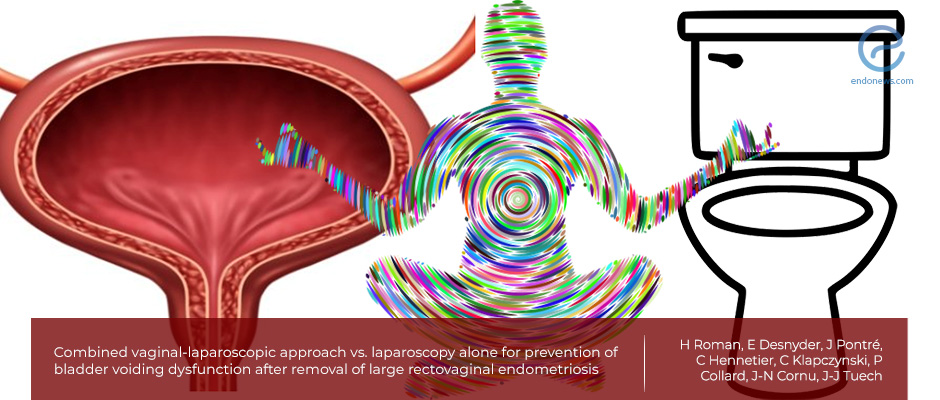The advantages of combined vaginal-laparoscopic approach on voiding dysfunction for rectovaginal endometriosis
Sep 4, 2020
The risk of postoperative bladder dysfunction decreases when a combined vaginal-laparoscopic approach is used.
Key Points
Highlights:
- This is the first study comparing the combined vaginal-laparoscopic approach and laparoscopic only approach in patients with large rectovaginal nodules focusing on bladder function.
Importance:
- Since the injury risk to the pelvic splanchnic nerves at the level of the paravagina is probably decreased, the combined vaginal-laparoscopic approach may reduce the risk of postoperative bladder dysfunction.
What's done here:
- The effect of combined vaginal-laparoscopic approach and laparoscopic approach only on postoperative bladder dysfunction is compared.
- One hundred and thirty-two patients who underwent surgery for rectovaginal endometriosis, vaginal infiltration measuring> 3 cm were analyzed.
Key Results:
- The patients managed by a combined vaginal-laparoscopic approach reported a greater effect on the quality of life, based on gastrointestinal symptoms and infertility.
- Early postoperative voiding difficulty was observed 14.7% and 24.3% of cases and controls, respectively.
- A significant decrease in the risk of intermittent self-catheterization at the time of discharge was detected.
Limitations:
- Since the effect two surgical techniques are compared after the time of the introduction of the new technique with patients managed before this time point, there may be a bias associated with a surgeon’s experience.
- The design of the study is retrospective.
- Associated endometriotic lesions were heterogeneous.
- There is a lack of routine preoperative urodynamic assessment in the participants.
Lay Summary
The patients with rectovaginal endometriotic nodules with extensive vaginal infiltration who are managed combined vaginal-laparoscopic approach have a lower risk of postoperative bladder dysfunction when compared to surgery via laparoscopy alone. This is according to a manuscript published in the Journal of Visceral Surgery.
Led by Dr. Roman Horace, a team of researchers from France, Australia, and Denmark conducted a retrospective comparative cohort study on 132 patients with deep rectovaginal endometriosis with vaginal infiltration measuring more than 3cm in diameter.
In this study where 62 patients underwent surgery via the combined vaginal-laparoscopic approach and 71 patients underwent surgery via the laparoscopic route alone, all surgeries were performed by a single surgeon.
The preoperative urodynamic assessment showed abnormal results in 27.3% and 11.1% of cases and controls, respectively. Early postoperative voiding difficulty was seen 14.7% and 24.3% of cases and controls respectively. In the participants of the study, a significant decrease in the risk of intermittent self-catheterization at the time of discharge was observed. Only one case and 6 controls had persistent voiding dysfunction 3 months after surgery. A greater effect on the quality of life due to the presence of gastrointestinal symptoms and a higher rate of documented infertility were reported by the patients managed by a combined vaginal-laparoscopic approach.
The authors believe that the effect of the lateral extension of postoperative edema and inflammation on early postoperative bladder function may be limited by keeping narrow surgical margins during nodule excision by the vaginal route.
Given the low prevalence of deeply infiltrating rectovaginal nodules, the authors underlined the need for larger comparative studies and multicentric prospective randomized trials.
Research Source: https://pubmed.ncbi.nlm.nih.gov/32747305/
deeply infiltrating endometriosis postoperative complications bladder atony bladder dysfunction vaginal approach dyschesia laparoscopy endometriosis

